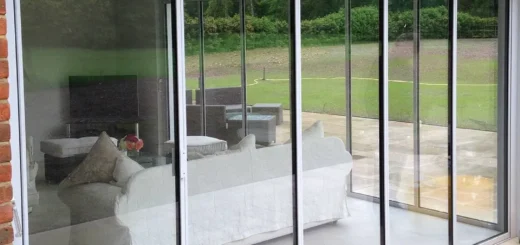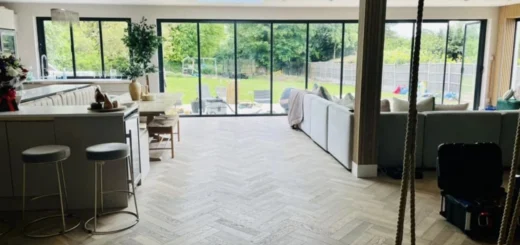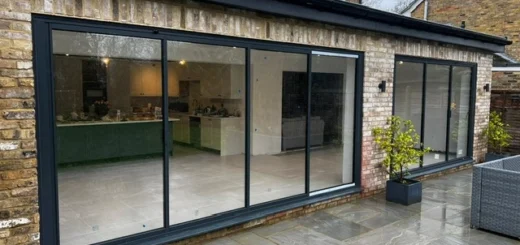Garden Sliding Doors: Everything You Need to Know
Table of Contents
Features of Garden Sliding Doors
Garden sliding doors offer a unique blend of form and function. Unlike traditional French doors or bifold doors, sliding doors feature glass panels which glide smoothly along tracks. They’re particularly well-suited to our unpredictable climate, allowing you to enjoy garden views year-round while maintaining a comfortable indoor temperature.
Glazing Options
Double glazing is standard, with two panes of glass separated by a layer of inert gas. This setup effectively reduces heat loss, keeping your home warm during chilly winters. For those seeking extra insulation, triple glazing is worth considering. It adds a third pane of glass, further improving thermal efficiency.
Some manufacturers offer low-emissivity (low-E) coatings on the glass. These microscopically thin metal layers reflect heat back into your home, boosting energy efficiency. In summer, they help keep interiors cool by reflecting some of the sun’s heat away.
For homes in noisier areas, acoustic glass is an option worth exploring. This specially designed glazing reduces sound transmission, creating a more peaceful indoor environment even when your garden faces a busy road.
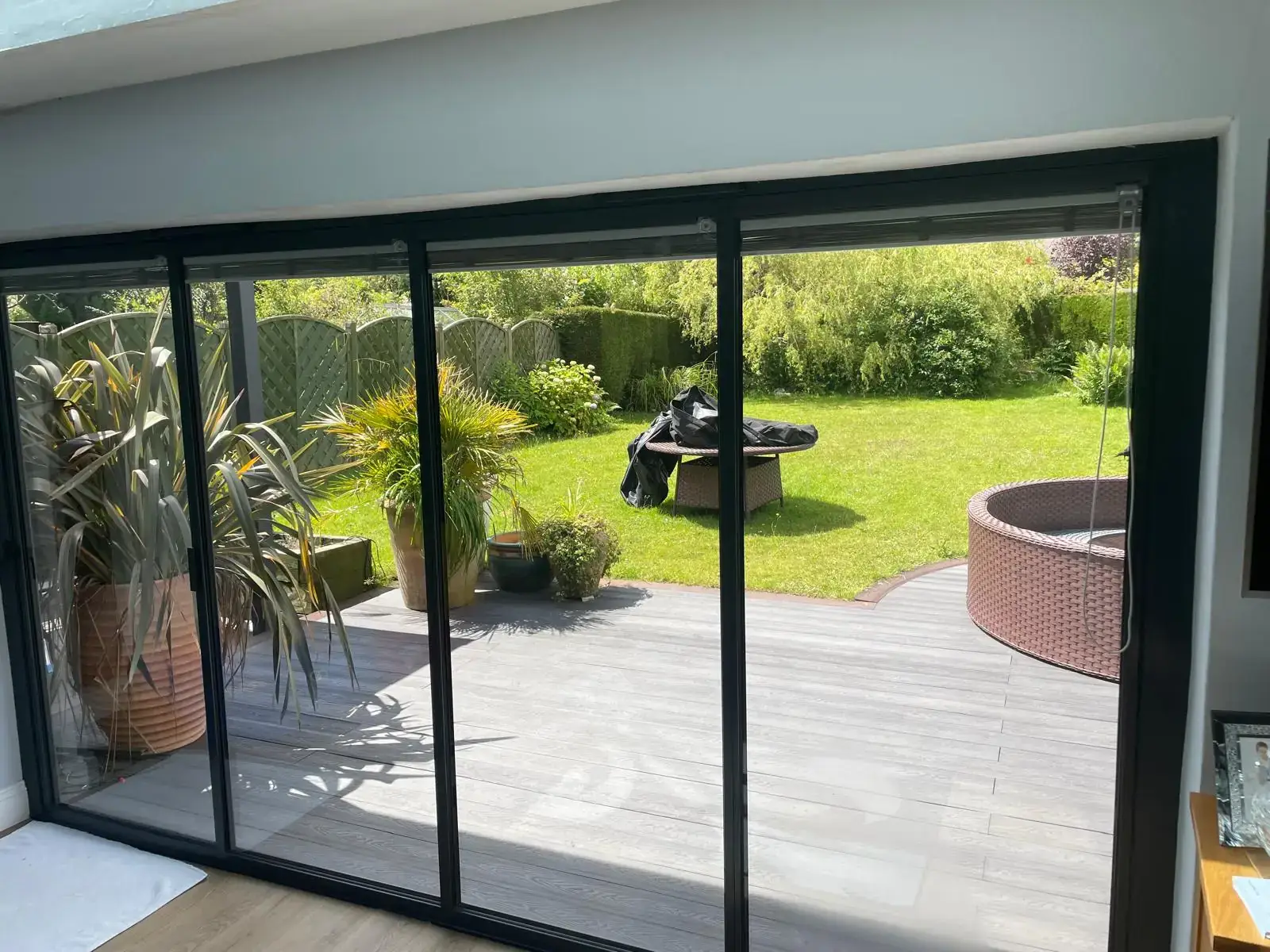
Frame Materials
uPVC frames are popular due to their affordability and low maintenance requirements. They resist weathering well, making them suitable for the UK’s often damp climate. However, some homeowners find their appearance less appealing than other materials.
Aluminium frames offer a sleeker, more modern look. They’re incredibly strong, allowing for larger glass panels and thinner frames that improve your view of the garden. Powder-coated finishes provide excellent protection against corrosion, ideal for coastal areas where salt air can be an issue.
Space Efficiency
Unlike hinged doors that swing open, sliding panels move parallel to the wall. This makes sliding garden doors ideal for smaller British homes where every square metre counts. You can place furniture right up to the door without worrying about clearance space.
Large sliding doors can create an impressive opening, with some systems allowing up to 90% of the aperture to be clear when fully open. This creates a dramatic “glass wall” effect. Even when closed, the large glass panels make your room feel more spacious by bringing in natural light and providing unobstructed views of your garden.
Slide and Stack Systems
For those wanting even more flexibility, consider a stacking variant of sliding garden doors such as slide and fold patio doors. These doors fold and slide to one side, creating an even wider opening than standard sliding doors. They’re particularly useful for entertaining, allowing guests to move freely between your home and garden during summer gatherings.
Selecting Sliding Garden Doors
The doors you select will affect not only your home’s appearance but also its comfort and energy efficiency. Modern sliding doors come in a variety of styles and configurations, so it’s important to consider your specific needs and preferences.
Door Dimensions
The size of your doors will depend on the available wall space and the desired opening. Larger doors can create a striking visual impact, but they may not be suitable for every home. Measure the height and width of your current opening, and don’t forget to account for the frame thickness.
For a truly expansive feel, some homeowners opt for floor-to-ceiling sliding garden doors. These tall doors can make your room feel larger and brighter. However, they may require additional structural support.
Door Configurations
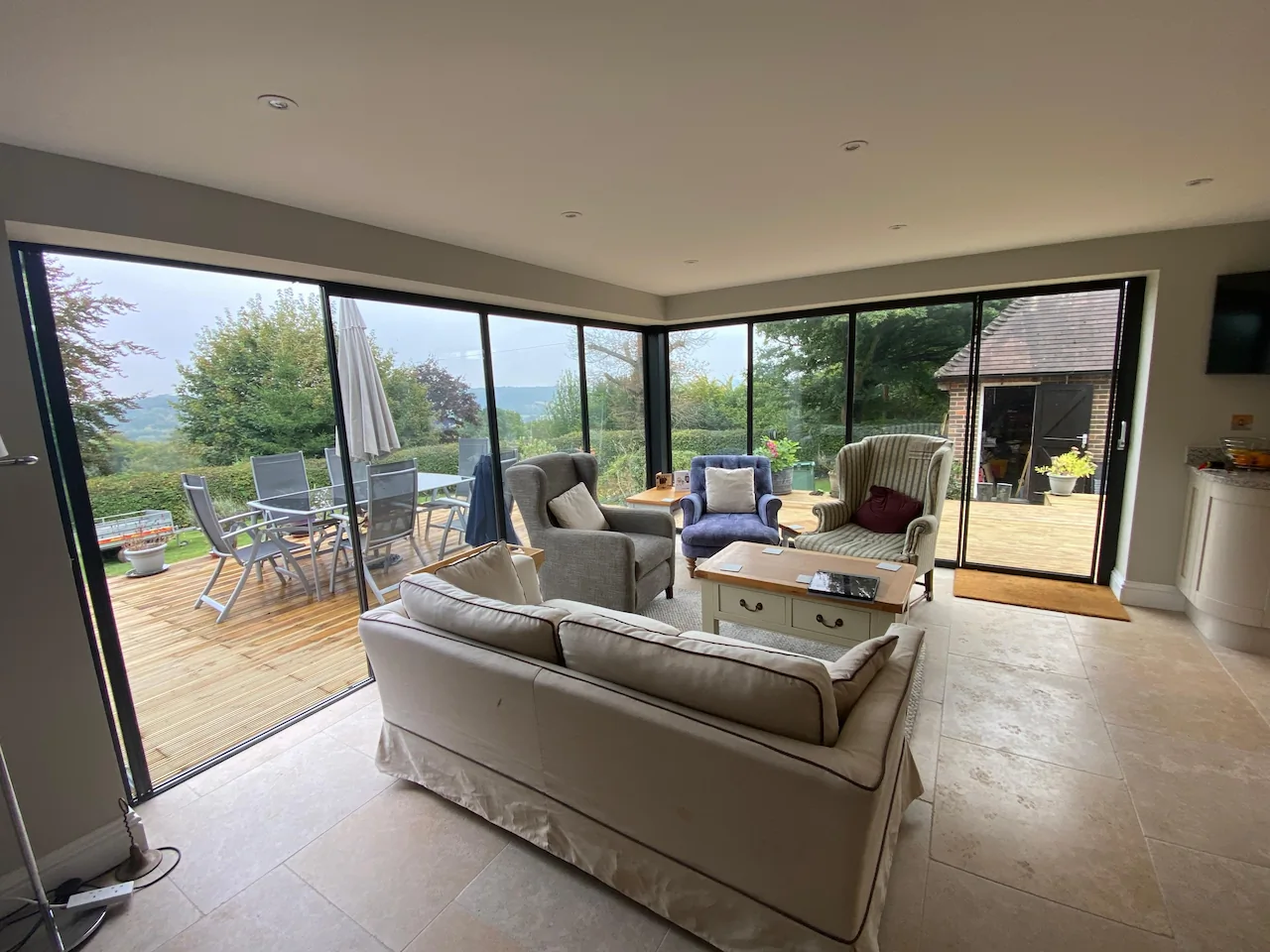
Garden sliding doors offer various configuration options to suit different spaces and preferences. The most common setup is a simple two-panel system, where one panel slides behind the other. For wider openings, you might consider a three or four-panel configuration. External glass doors with multiple panels can create an impressive wall of glass when closed, and a large opening when slid apart.
Some systems allow for corner setups, where two sets of slide doors meet at a 90-degree angle. When both are open, this creates a striking, unobstructed view of your garden. It’s a popular choice for modern homes looking to make a bold architectural statement.
Threshold Types
The threshold is where your sliding garden doors meet the floor. A standard threshold provides good weatherproofing but creates a small step between inside and outside. For a more seamless look, consider a low-threshold option. These designs reduce the height difference, making it easier to move between areas.
Flush thresholds are increasingly popular in modern homes. They create a completely level surface between your interior floor and the outside, ideal for wheelchair users or families with young children. However, they require careful installation to ensure proper drainage and prevent water ingress.
Handles and Hardware
The handles and hardware on your garden sliding doors are a great opportunity to add a personal touch to your design. Sleek, minimal handles are popular with contemporary homes, while more traditional designs might opt for classic lever handles.
Consider the locking mechanism when choosing your hardware. Multi-point locking systems offer excellent security, engaging at several points along the door frame when closed. Some slide doors feature built-in alarms or can be integrated with home security systems for added peace of mind.
For ease of use, look for handles with a smooth, ergonomic design. If you have children or mobility issues, you might want to choose handles that are easy to grip and operate. Some systems even offer motorised opening and closing, which can be controlled via a remote or smartphone app.
Installing Garden Sliding Doors
Home Preparation
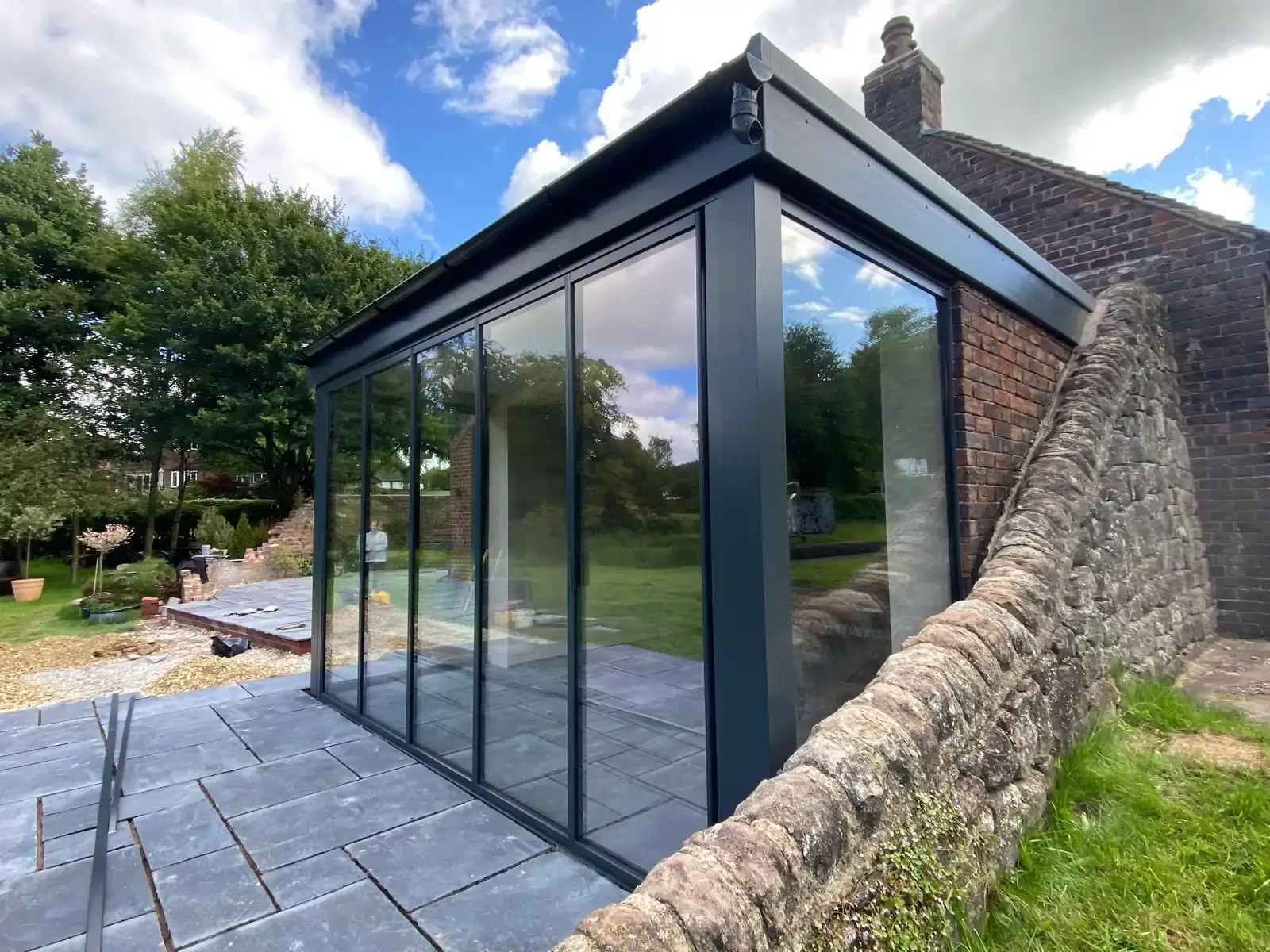
Before your garden sliding doors arrive, there’s groundwork to be done. Clear the area around the existing doorway, both inside and out. Remove any furniture, plants, or decorations that might obstruct the work area. If you’re replacing old doors, you’ll need to arrange for their disposal.
Check the structural integrity of the opening. Garden sliding doors are heavier than standard doors, so the surrounding wall must be able to support their weight. Look for signs of dampness or damage in the existing frame or wall. Addressing these issues before installation will prevent problems down the line.
Sliding garden doors often work best with a consistent floor level from inside to outside. You might need to adjust interior flooring or create a new patio area to achieve this.
Building Regulations
In the UK, installing garden sliding doors often falls under ‘permitted development’. However, it’s always wise to check with your local planning authority. Some areas have specific rules, especially for listed buildings or homes in conservation areas.
Building regulations are another important factor. These cover aspects like thermal efficiency, ventilation, and safety. Garden sliding doors must meet certain U-value requirements to ensure they don’t compromise your home’s energy performance. The U-value measures how well a product prevents heat from escaping.
Structural stability is also covered by building regulations. The lintel above your garden sliding doors must be strong enough to support the weight of the wall above. In some cases, you might need a structural engineer to assess and design an appropriate support.
Maintenance of Sliding Garden Doors
Proper care of your garden sliding doors ensures they remain in top condition for years to come. Regular maintenance not only preserves their appearance but also keeps them operating smoothly and efficiently.
Seasonal Maintenance
As the seasons change, so do the maintenance needs of your garden sliding doors. In spring, inspect the tracks for any debris that might have accumulated over winter. Remove leaves, twigs, or other objects that could impede the doors’ movement. Check the weatherstripping around the frame for any signs of wear or damage.
Summer brings increased use of sliding garden doors. Keep an eye on the rollers and tracks, cleaning them more frequently if needed. Apply a silicone-based lubricant to the rollers and locks to keep them moving smoothly. This is also a good time to check the alignment of your doors, adjusting them if they’re not sliding easily.
Autumn calls for vigilance against falling leaves and increased moisture. Clear the tracks regularly to prevent build-up of debris. Check that drainage holes in the frame are clear to allow water to escape. As temperatures drop, ensure the weatherstripping is in good condition to maintain your home’s energy efficiency.
Winter can be harsh on garden sliding doors. Keep snow and ice away from the threshold to prevent damage. If you’re not using the doors frequently, open and close them periodically to prevent seals from sticking. Check for any draughts around the frame and address them promptly to keep your home warm and dry.
Cleaning Methods
Keeping your garden sliding doors clean not only improves their appearance but also extends their lifespan. Start with the glass panels. Use a soft, lint-free cloth and a solution of mild detergent and warm water. Avoid abrasive cleaners or tools that could scratch the glass. For stubborn marks, a mixture of white vinegar and water can be effective.
The frames require different care depending on their material. For uPVC frames, warm soapy water and a soft cloth are usually sufficient. Aluminium frames can be cleaned similarly, but avoid using anything too abrasive that could damage the powder coating. Wooden frames might need special wood cleaners – always follow the manufacturer’s recommendations.
Don’t forget the tracks and rollers of your sliding doors. Use a vacuum cleaner with a narrow nozzle to remove dust and debris from the tracks. Follow up with a damp cloth to pick up any remaining dirt. For the rollers, a soft brush can help dislodge stubborn grime. After cleaning, apply a small amount of silicone spray to keep everything moving smoothly.
Lastly, pay attention to the hardware. Clean handles, locks, and other metal components with a slightly damp cloth, then dry thoroughly to prevent rust. If your garden sliding doors have a stainless steel finish, you might want to use a specialist stainless steel cleaner to maintain its lustre.
Remember, while cleaning, it’s a good opportunity to inspect your doors for any signs of wear or damage. Catching issues early can prevent more serious problems down the line, ensuring your sliding garden doors continue to perform well and look great for years to come.
Add-Ons for Garden Sliding Doors
When selecting garden sliding doors, there are several extra features and options to think about. These additional elements can improve comfort, security, and efficiency.
Insect Screens and Blinds
Insect screens are a practical addition to garden sliding doors, especially if you live in an area with lots of bugs. These screens allow you to enjoy fresh air without unwelcome visitors. They’re typically made from a fine mesh that’s almost invisible when viewed from a distance, so they won’t obstruct your garden view.
Integrated blinds offer privacy and light control. Some sliding aluminium patio doors come with blinds sandwiched between the glass panes. This design protects the blinds from dust and damage, making them low-maintenance. You can adjust these blinds using a magnetic slider on the frame, giving you easy control over light and privacy.
For a more traditional look, you might opt for curtains or external blinds. These can add a softer touch to the appearance of your garden sliding doors. Remember to choose materials that can withstand exposure to sunlight to prevent fading.
Sustainable Options
Eco-friendly choices are becoming increasingly popular for home improvements, including garden sliding doors. Look for doors made from sustainable materials or those manufactured using energy-efficient processes. Some companies offer aluminium patio doors made from recycled materials, reducing their environmental impact.
Energy efficiency is another key aspect of sustainability. Choose garden sliding doors with high-performance glazing to reduce heat loss in winter and heat gain in summer. This can help lower your energy bills and reduce your carbon footprint. Some manufacturers offer glazing with special coatings that reflect heat back into your home during colder months.
Consider the lifespan of your doors too. Durable materials like aluminium can last for decades with proper care, reducing the need for replacements. This longevity makes them a more sustainable choice in the long run, despite potentially higher upfront costs.
Security Features
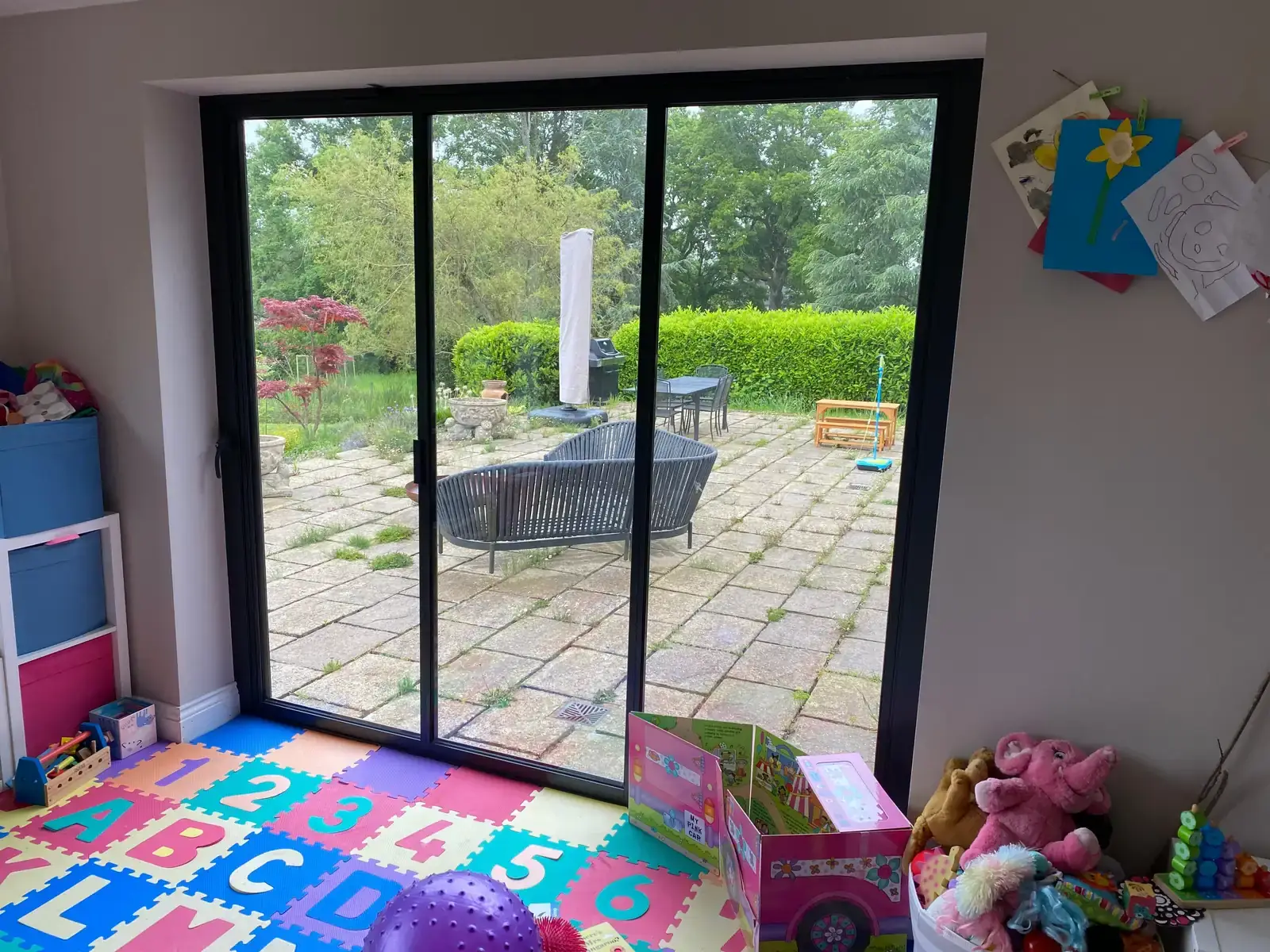
Security is a top priority for many homeowners when choosing sliding doors to gardens. Modern sliding patio doors offer several advanced security features to keep your home safe. Multi-point locking mechanisms are a common feature, securing the door at multiple points along the frame when locked.
Toughened or laminated glass adds an extra layer of security. This glass is more difficult to break than standard glass, deterring potential intruders. Some sliding garden doors also feature anti-lift mechanisms, which prevent the door from being lifted off its tracks from the outside.
Garden Sliding Doors FAQ
What are garden sliding doors?
Garden sliding doors are external doors that open by sliding horizontally along a track. They typically feature large glass panels that offer expansive views of your garden or outdoor space. These doors are popular in British homes for their ability to make it easy to leave or enter the garden, whilst providing excellent natural light and space-saving benefits.
How wide can garden sliding doors be?
The width of garden sliding doors can vary greatly, with some systems able to span impressive distances. Triple-track sliding doors are particularly useful for wider openings, as they allow for multiple panels to slide independently. These systems can often accommodate openings of up to 6 metres or more, depending on the manufacturer and specific design.
Can I add blinds to my garden sliding doors?
Yes, you can add blinds to your garden sliding doors. Many homeowners opt for integral blinds, which are installed between the panes of glass. These blinds are protected from dust and damage, making them low-maintenance and long-lasting. Alternatively, you can install traditional blinds or curtains, but ensure they’re compatible with the door’s operation.
What’s the difference between sliding and French doors?
Sliding doors move horizontally along a track, while French doors are hinged and swing open like traditional doors. Sliding doors typically offer larger glass areas and don’t require clearance space to open, making them ideal for smaller rooms or patios. French doors, on the other hand, can open fully and often have a more traditional aesthetic that suits period properties.
What are the pros and cons of garden sliding doors?
Garden sliding doors offer excellent views, abundant natural light, and space-saving benefits. Double or triple glazed patio doors are also often energy-efficient when properly installed and can increase a home’s value. However, they can be more expensive than traditional doors, may require professional installation, and some designs might have limitations on opening width compared to bi-fold doors.
What’s the difference between sliding doors and bifold doors?
Sliding doors (also known as patio doors) typically consist of large glass panels that slide along a track, while bifold doors (also known as concertina glass doors, folding doors, or bi-folding doors) fold in sections. Sliding doors generally offer unobstructed views when closed and are ideal for wider openings, while bifold doors can open up almost the entire aperture but have more visible frames when closed. Your choice might depend on factors like available space, desired aesthetic, and how you plan to use the doors. For more information, please see our comparison of sliding doors and bifold doors.
What are pocket sliding doors?
Pocket sliding doors are a type of sliding door that disappears into a cavity in the wall when opened. This design allows for a completely unobstructed opening, as the door panels are hidden from view. While pocket doors can create a striking effect, they require specific wall construction to accommodate the pocket, which can make them more complex and costly to install than standard sliding doors.
What are some alternatives to garden sliding doors?
There are several alternatives to garden sliding doors, including slide and fold doors and folding external doors. French doors are a classic option, offering a traditional look and the ability to open fully. Bifold doors, which fold in sections, can open up almost an entire wall. For a modern twist, pivot doors provide a dramatic, large single panel that rotates on a central axis.
About SunSeeker Doors
With over 20 years of experience, SunSeeker Doors remains at the forefront of door design with our quality-tested patio doors and related products, including the bespoke UltraSlim aluminium slide and pivot door system, Frameless Glass Doors, and Slimline Sliding Glass Doors. All of our doors are suitable for both internal and external use.
To request a free quotation, please use our online form. You may also contact 01582 492730, or email info@sunseekerdoors.co.uk if you have any questions.


